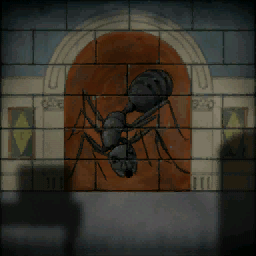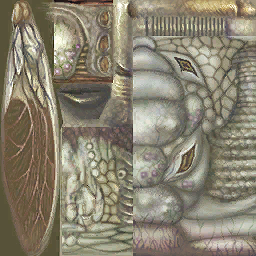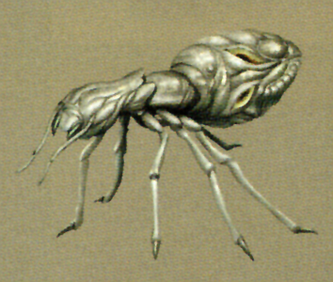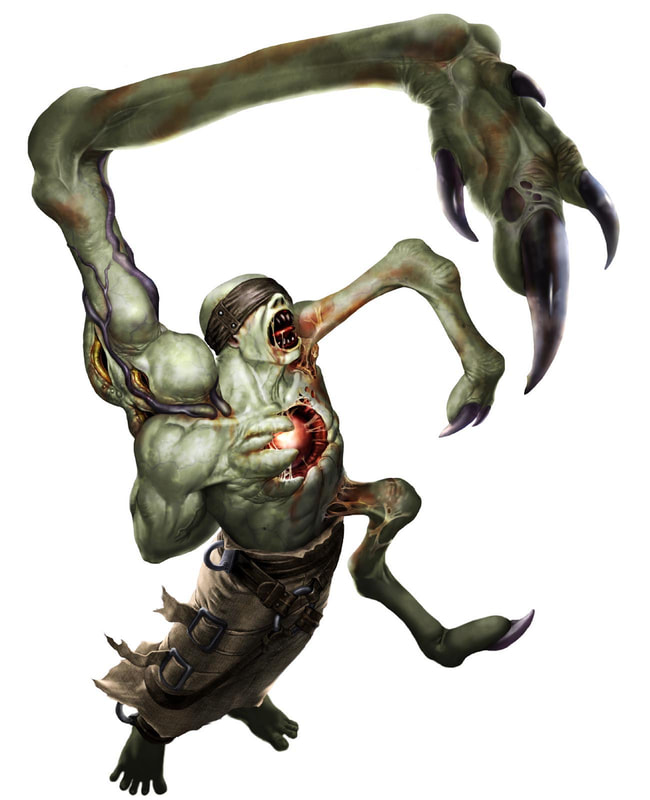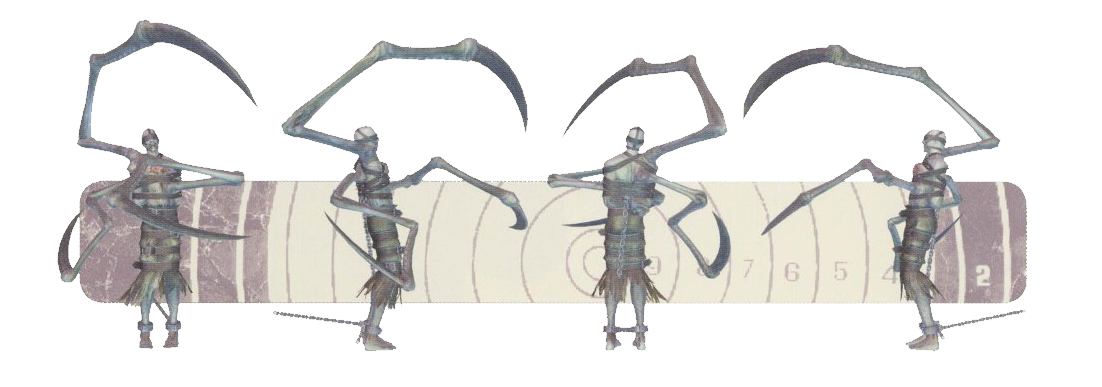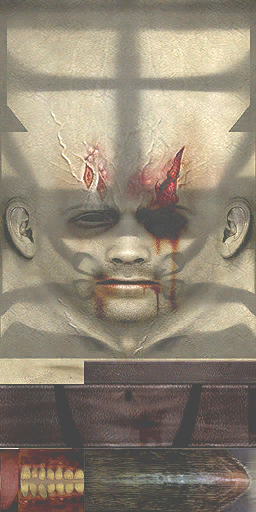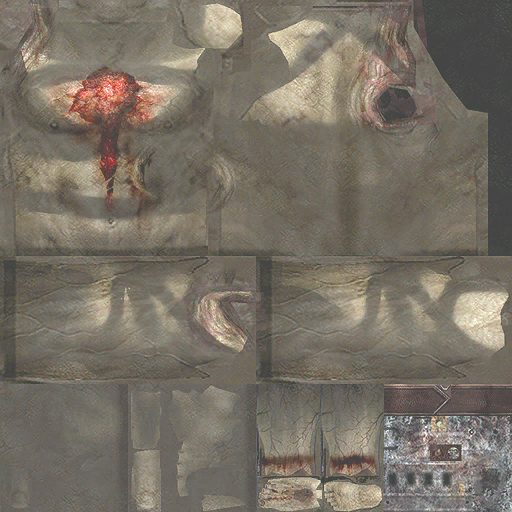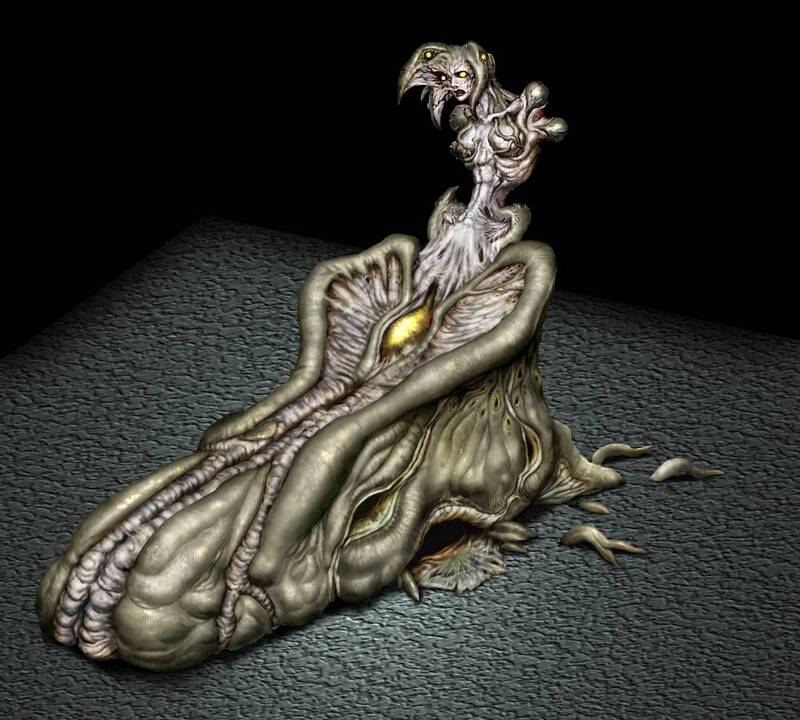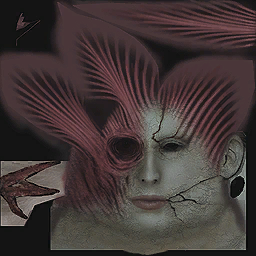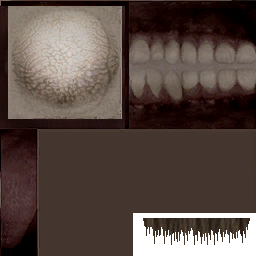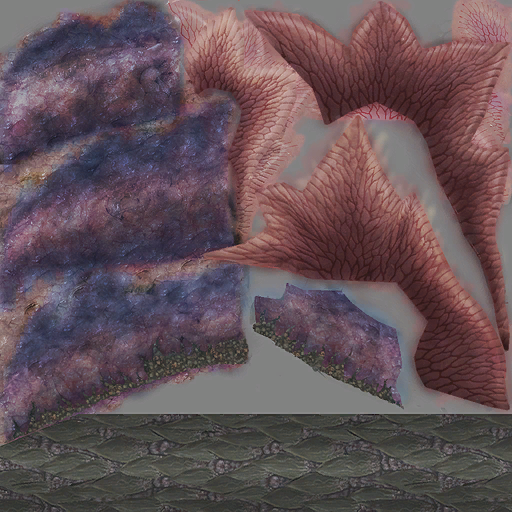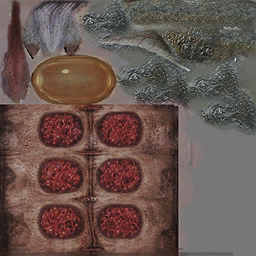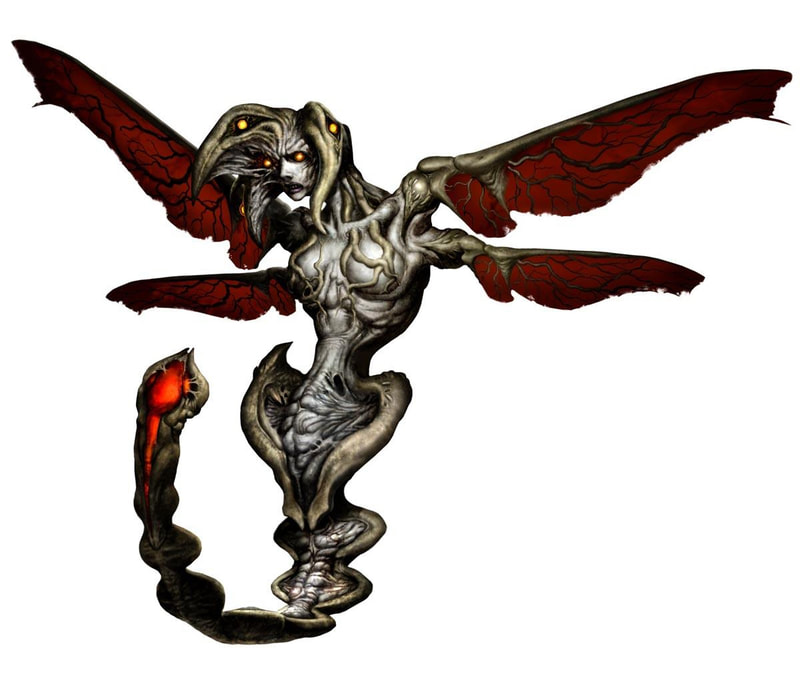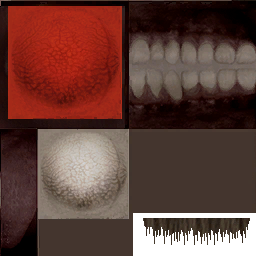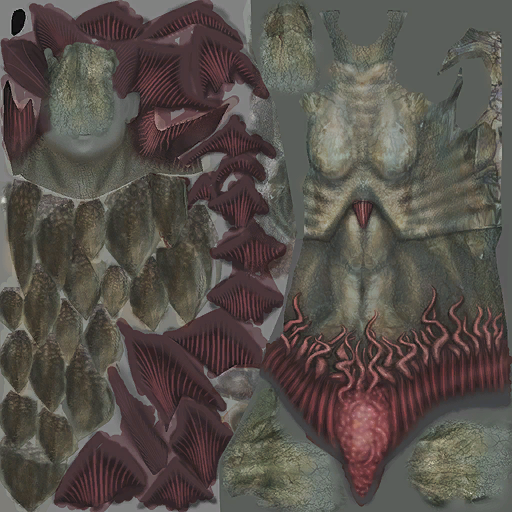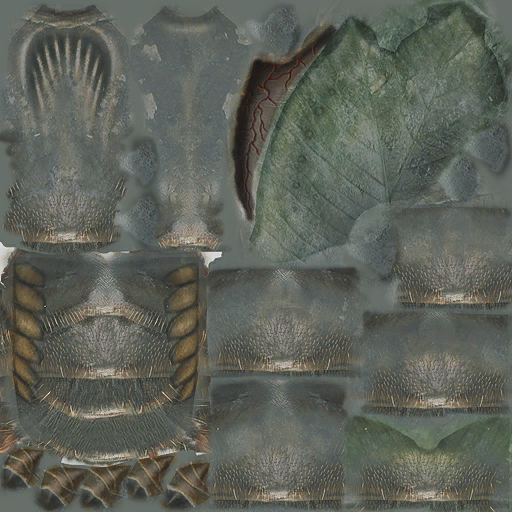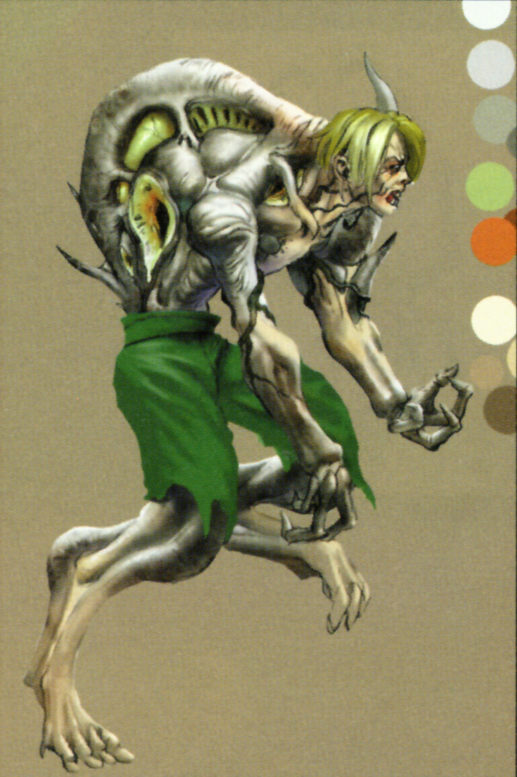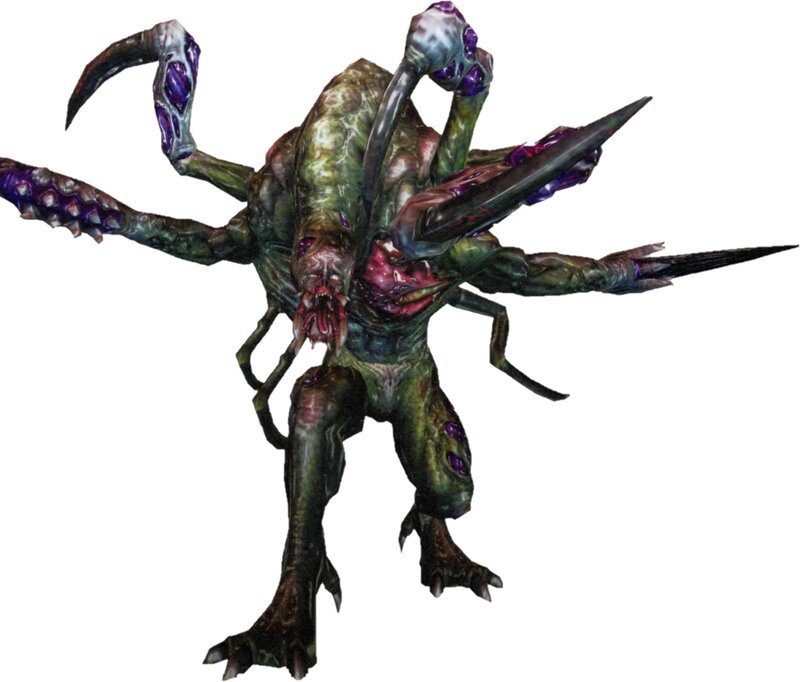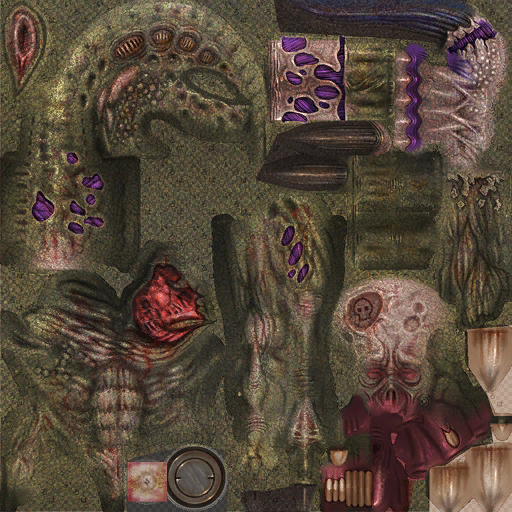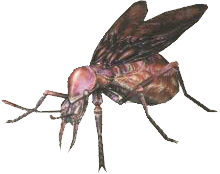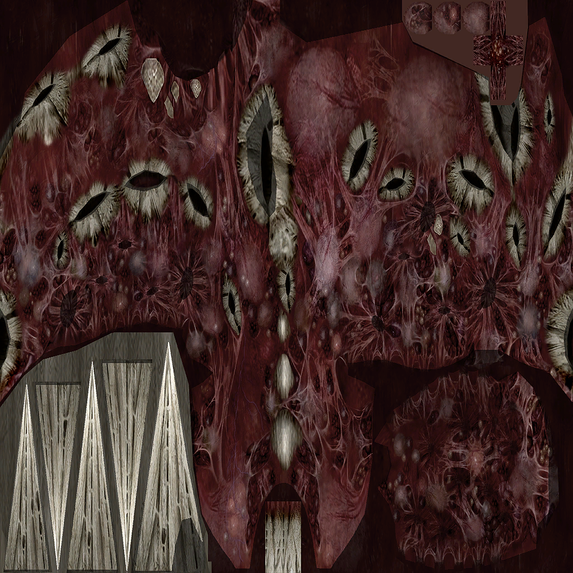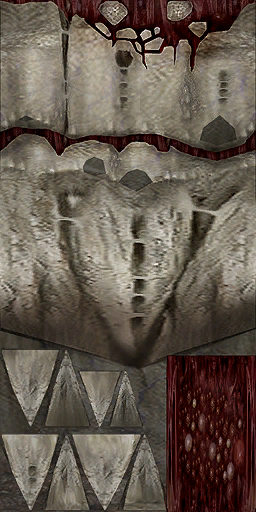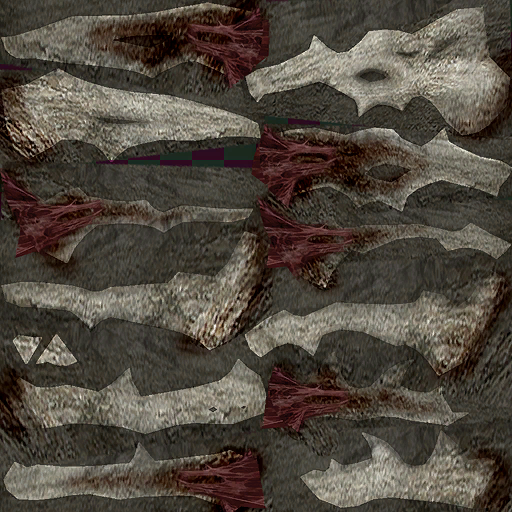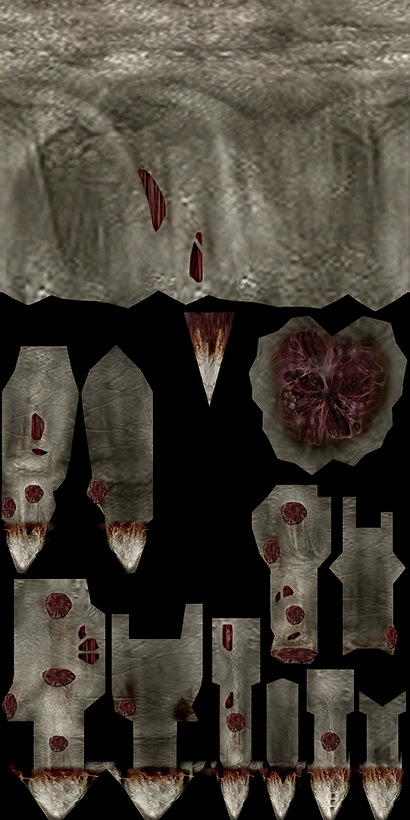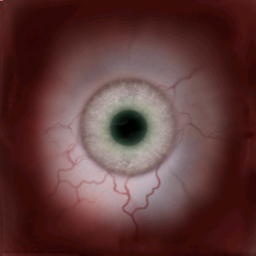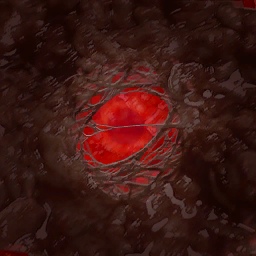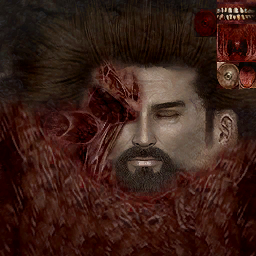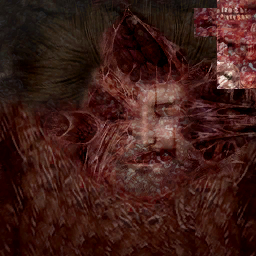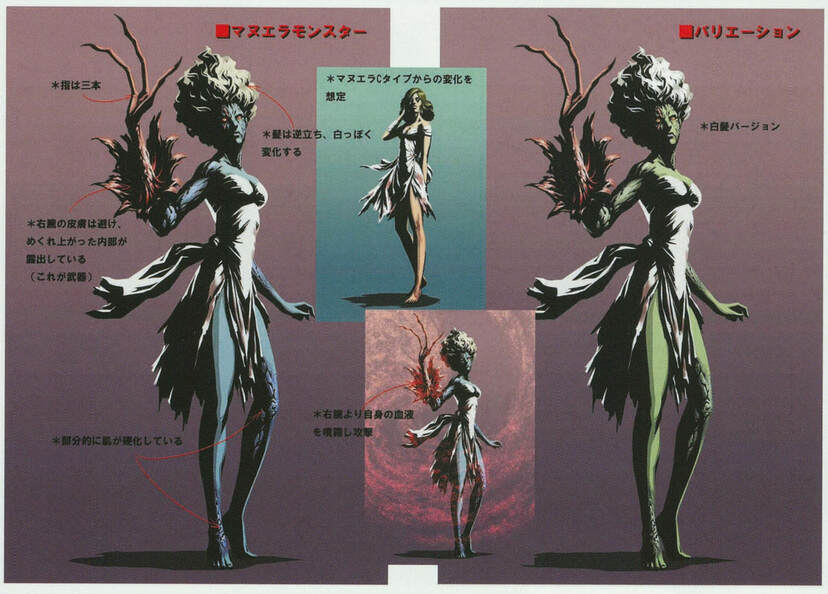Alexia Ashford, using her unnatural intelligence, created the Tyrant-Veronica Virus using Progenitor, queen ant genes, plant genes, and another ancient virus. It is considered a "t-Virus" exclusively due to it being developed under the t-Virus project, despite its relation to James Marcus' t-Virus being dubious. It was named after Veronica Ashford, whom Alexia was a clone of, and was designed to accomplish her ambition modeled after ant society, where the colony lives in dependence to its Queen.
History
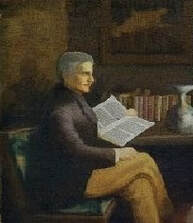
The aristocratic Ashford family was instrumental in founding the Umbrella Corporation thanks to the head of the family at the time, Dr. Edward Ashford. Edward discovered the Progenitor Virus with James Marcus and Oswell E. Spencer, and his t-Virus (the name for Umbrella-made variations of Progenitor designed to create living weapons and grant immortality) research laid the groundwork for much of Umbrella's later research. However, Spencer had Edward assassinated to consolidate his control over the company. The next in line for control of the Ashford family, Edward's son Alexander, lacked the skills in virology to live up to the example of his father, and the Ashford family's fame and influence within the company waned.

Alexander, aware of this, began a project that aimed to create an heir that could restore the position of the Ashford name. Within the lab he founded in Antarctica, he advanced the Code Veronica project. The project relied on two elements:
1. Resurrecting or recreating Veronica Ashford. Veronica was an ancestor of Alexander, famed for her incredible intelligence and beauty.
2. Manipulating human intelligence artificially.
Using genetic material taken from Veronica's mummified corpse at the Ashford's European estate, Alexander managed to clone her. At the same time, Alexander increased her intelligence using his research into the human mind. The experiment ended in the creation of two children: Alexia and Alfred. Alexia was a success with unheard-of intelligence, while Alfred's intellect was barely above average.
1. Resurrecting or recreating Veronica Ashford. Veronica was an ancestor of Alexander, famed for her incredible intelligence and beauty.
2. Manipulating human intelligence artificially.
Using genetic material taken from Veronica's mummified corpse at the Ashford's European estate, Alexander managed to clone her. At the same time, Alexander increased her intelligence using his research into the human mind. The experiment ended in the creation of two children: Alexia and Alfred. Alexia was a success with unheard-of intelligence, while Alfred's intellect was barely above average.
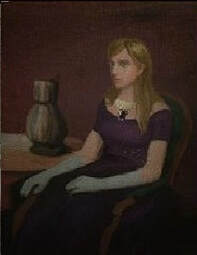
On the 27th of July, 1981, 10-year-old Alexia Ashford took over Umbrella's Antarctic lab as Chief Researcher. She took the place of her adoptive father and creator, Alexander, who had failed at making any notable advancements in t-Virus research since he first founded the lab.
Alexia, during her t-Virus research, became fascinated with the ecology of ants. While examining the genes of a queen ant, she discovered within them the remnants of an ancient, natural virus. This virus had the innate ability to cause mutations in its hosts which resembled the traits of many different kinds of insects. It is inferred that, like the Progenitor Virus, this virus was involved in the development of insect life on Earth (although Progenitor's ability to infect and mutate arthropods suggests it had a more universal role. It could even be that the two viruses are related. The same applies to the Abyss with deep sea life). This virus was named the “Veronica Virus” by Alexia’s “father”, Alexander, after his ancestor Veronica Ashford. The Veronica Virus was then applied to the t-Virus research being performed at the Antarctic Facility.
Alexia, during her t-Virus research, became fascinated with the ecology of ants. While examining the genes of a queen ant, she discovered within them the remnants of an ancient, natural virus. This virus had the innate ability to cause mutations in its hosts which resembled the traits of many different kinds of insects. It is inferred that, like the Progenitor Virus, this virus was involved in the development of insect life on Earth (although Progenitor's ability to infect and mutate arthropods suggests it had a more universal role. It could even be that the two viruses are related. The same applies to the Abyss with deep sea life). This virus was named the “Veronica Virus” by Alexia’s “father”, Alexander, after his ancestor Veronica Ashford. The Veronica Virus was then applied to the t-Virus research being performed at the Antarctic Facility.
Alexia combined queen ant genes containing the Veronica Virus with the Progenitor Virus. This resulted in the creation of the prototype for a new hybrid virus: the t-Veronica Virus. It is sometimes stated that the t-Virus created by James Marcus was combined with this new strain as well, which would make t-Veronica a hybrid of three different viruses. Alexia finished t-Veronica by fusing it with plant genes.
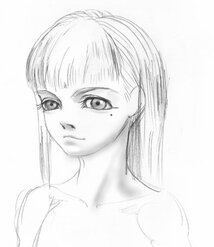
Due to her modified, unnatural intelligence, Alexia lacked the ability to relate to others, and considered herself above all of humanity. In her eyes, the only purpose humanity could serve would be to serve her as eusocial insects would serve a single queen. To this end, Alexia steered t-Veronica development towards enslaving every person on the planet and subjugating them to her will. While t-Veronica development was known to the rest of Umbrella, the true aim of its research was kept a total secret. Ostensibly, t-Veronica was thought to be geared towards B.O.W. development.
After Alexia and Alfred discovered the truth behind their birth, they forcibly injected Alexander with the prototype t-Veronica in what became the first human trial. He suffered extensive brain damage and unfavorable mutations, showing that t-Veronica failed to circumvent the main issues in Progenitor-derived viruses. However, Alexia formulated a way to avoid this issue - by slowing the spread of the virus in the body using cryogenic preservation.
After Alexia and Alfred discovered the truth behind their birth, they forcibly injected Alexander with the prototype t-Veronica in what became the first human trial. He suffered extensive brain damage and unfavorable mutations, showing that t-Veronica failed to circumvent the main issues in Progenitor-derived viruses. However, Alexia formulated a way to avoid this issue - by slowing the spread of the virus in the body using cryogenic preservation.
(Credit to Ridley, Newsbot and Crimson-Head for the Young Alexia (or Hilda) Art
At the age of 12, Alexia injected herself with t-Veronica and entered cryosleep. It was estimated that it would take 15 years for Alexia to fully adapt to t-Veronica. In the meantime, Alfred was to take over the Antarctic Facility and watch over her as she slept. To maintain the secrecy of her plan, Alexia faked her death, and in her absence the Ashford family once again sunk in prominence in the company.
At the end of 1998, Alexia awoke from her cryogenic sleep. She injected Steve Burnside with the virus contained in her body, which had mutated over the decade and a half into a new strain dubbed "t-Alexia". Before she could enact the next stage of her plan - global infection - Alexia was utterly destroyed by Chris Redfield.
Albert Wesker managed to recover t-Alexia by extracting it from the body of Steve, and gave it to Umbrella's rival company. Research was performed on its potential usefulness in bioweapons development, but due to the way Alexia designed it, this proved impractical. The virus itself was also too dangerous to sell on its own. Despite this, Wesker sold a sample of the virus to Javier Hidalgo, leader of the Sacred Snakes crime syndicate in South America. This was in spite of the fact Javier was an unstable man in the worst possible environment (the Amazon) for that virus, which risked a global biohazard and the destruction of the Amazon's oxygen output. Wesker was already toying with his end goal - the eradication of the human race.
Javier sought to use t-Veronica to treat the fatal illness contracted by his daughter Manuela. Following a raid on his compound in 2002 by US agents Leon S. Kennedy and Jack Krauser, Manuela was taken into the custody of the US government. Using his connections in the government, Derek Simmons acquired a sample of t-Veronica taken from Manuela and gave it to Carla Radames. She used t-Veronica in conjunction with elements of the t-Virus to make t-02. She then combined t-02 with the G-Virus to develop the C-Virus.
When Uroboros development began in 2006, TRICELL used the t-Alexia sample given to them by Wesker in 2003 as a reference, along with the G-Virus sample recovered from G-Curtis
At the end of 1998, Alexia awoke from her cryogenic sleep. She injected Steve Burnside with the virus contained in her body, which had mutated over the decade and a half into a new strain dubbed "t-Alexia". Before she could enact the next stage of her plan - global infection - Alexia was utterly destroyed by Chris Redfield.
Albert Wesker managed to recover t-Alexia by extracting it from the body of Steve, and gave it to Umbrella's rival company. Research was performed on its potential usefulness in bioweapons development, but due to the way Alexia designed it, this proved impractical. The virus itself was also too dangerous to sell on its own. Despite this, Wesker sold a sample of the virus to Javier Hidalgo, leader of the Sacred Snakes crime syndicate in South America. This was in spite of the fact Javier was an unstable man in the worst possible environment (the Amazon) for that virus, which risked a global biohazard and the destruction of the Amazon's oxygen output. Wesker was already toying with his end goal - the eradication of the human race.
Javier sought to use t-Veronica to treat the fatal illness contracted by his daughter Manuela. Following a raid on his compound in 2002 by US agents Leon S. Kennedy and Jack Krauser, Manuela was taken into the custody of the US government. Using his connections in the government, Derek Simmons acquired a sample of t-Veronica taken from Manuela and gave it to Carla Radames. She used t-Veronica in conjunction with elements of the t-Virus to make t-02. She then combined t-02 with the G-Virus to develop the C-Virus.
When Uroboros development began in 2006, TRICELL used the t-Alexia sample given to them by Wesker in 2003 as a reference, along with the G-Virus sample recovered from G-Curtis
Effects
t-Veronica was an amalgamation of the Veronica Virus, the Progenitor Virus, the t-Virus (possibly), queen ant genes, and plant genes. Such excessive recombination caused t-Veronica mutations to become extremely dramatic, fast, and explosive, particularly in favorable environments. Human hosts mutated by t-Veronica were even farther removed from what they once were than t-Virus mutants, yet not as far removed as G-Virus mutants. Their vitality and strength were far beyond the levels of natural animals, much like other Progenitor-related mutants.
Unlike the normal t-Virus, t-Veronica managed to seemingly avoid any negative metabolic symptoms from arising in its hosts. This not only meant mutants created by t-Veronica were not in a state of constant starvation like Zombies, but that they resisted necrosis and rotting. However, when the virus was left to spread at its normal speed, it would still damage the brain cells of a host, like most Progenitor strains. While most hosts became powerful mutants instead of Zombies, they would still lose most of their intelligence. t-Veronica mutants would also become extremely aggressive and violent towards the uninfected, although the reason for this is unknown - it may have been due to hormonal abnormalities, changes in the brain, or insectoid instincts. Inside of Biohazard implies the behavior of Zombies may be due to some hidden, subconscious dark side of the human mind, and the same could apply to t-Veronica mutants.
Unlike the normal t-Virus, t-Veronica managed to seemingly avoid any negative metabolic symptoms from arising in its hosts. This not only meant mutants created by t-Veronica were not in a state of constant starvation like Zombies, but that they resisted necrosis and rotting. However, when the virus was left to spread at its normal speed, it would still damage the brain cells of a host, like most Progenitor strains. While most hosts became powerful mutants instead of Zombies, they would still lose most of their intelligence. t-Veronica mutants would also become extremely aggressive and violent towards the uninfected, although the reason for this is unknown - it may have been due to hormonal abnormalities, changes in the brain, or insectoid instincts. Inside of Biohazard implies the behavior of Zombies may be due to some hidden, subconscious dark side of the human mind, and the same could apply to t-Veronica mutants.
The capacity of Progenitor to rewrite human DNA combined with Veronica's insect properties allowed t-Veronica to give insectoid traits to humans. Because of this, hosts to t-Veronica typically appeared to be a cross between human and insect. The addition of plant genes as well led to the development of some plant characteristics - in particular, t-Veronica mutants would commonly have green skin, caused by the chlorophyll pigment found in plants.
The queen ant genes in the virus could potentially result in a prolonged lifespan in human hosts, as queen ants can live for up to 30 years due to their advanced ability to repair DNA and protein damage. The Progenitor Virus already has the capacity to reduce telomere shortening, and queen ant genes could have accentuated this to help unlock immortality.
Another unique mutation caused by t-Veronica is blood that combusts once coming into contact with oxygen, creating organic flamethrowers. This also causes some hosts to burst into flames upon death, due either to them hemorrhaging blood or to an increase in temperature caused by excessive regeneration. As this trait was not seen in Nosferatu, it may be a random mutation that arose in t-Alexia (a recombinant strain of t-Veronica found in Alexia's body).
The manifestation of the kind of powers t-Veronica mutants would acquire was not constant, with each individual having radically different traits. This was much like the G-Virus, but in contrast to Umbrella's primary t-Virus, which was stabilized to the point it had consistent effects in most animals.
The queen ant genes in the virus could potentially result in a prolonged lifespan in human hosts, as queen ants can live for up to 30 years due to their advanced ability to repair DNA and protein damage. The Progenitor Virus already has the capacity to reduce telomere shortening, and queen ant genes could have accentuated this to help unlock immortality.
Another unique mutation caused by t-Veronica is blood that combusts once coming into contact with oxygen, creating organic flamethrowers. This also causes some hosts to burst into flames upon death, due either to them hemorrhaging blood or to an increase in temperature caused by excessive regeneration. As this trait was not seen in Nosferatu, it may be a random mutation that arose in t-Alexia (a recombinant strain of t-Veronica found in Alexia's body).
The manifestation of the kind of powers t-Veronica mutants would acquire was not constant, with each individual having radically different traits. This was much like the G-Virus, but in contrast to Umbrella's primary t-Virus, which was stabilized to the point it had consistent effects in most animals.
Due to its plant and insect properties, the virus' infectious potential was enhanced in environments rife with insect and plant life. Humidity and temperature also affected it. This is why t-Veronica research was held in Antarctica, to reduce the threat of an outbreak. But once Alexia decided it was time to release it, she would use this to her advantage to infect the world. Being a Progenitor Virus (which created plant and animal life in the first place), t-Veronica will alter the ecosystem dramatically.
Control and Adaption
The primary, intended function of the t-Veronica Virus was to transplant the sociality of ants into humans. t-Veronica mutants would all be joined into a single, eusocial colony. While most hosts to the virus would be replaceable soldiers or workers, a single host would take on the position of a queen. Queen ants have no primary means of control over their "subjects" - they simply fulfill the role of reproduction in an ant colony, and are instinctually protected by the other ants for this reason. A Veronica "queen" would perform a similar role in that all subjects in her colony would be created by a strain of the virus coming from her body. But unlike true ant queens, t-Veronica queens would also have direct control over other, lesser hosts.
The inclusion of plant genes may have been to establish the control function of t-Veronica. Many plants produce pheromones and volatiles that affect insect behavior - typically to repel or attract them. They also use these to communicate with other plants, typically to warn of infestations. Alexia may have used these plant characteristics in conjunction with the Virus to produce a complex relationship in hosts. A single, dominant host could produce such chemicals and manipulate lesser hosts, be they insect, plant, or even human. In this way, a "Veronica Ecosystem" would be in perfect harmony with itself, regardless of the species of organisms within it.
In order to become a "Veronica Queen", a host would need to resist the degradation of brain cells caused by t-Veronica. Lesser hosts would be unable to resist a queen's commands in large part to their lessened intelligence, but only a host with a preserved brain could actually input commands. The only way to avoid brain cell rejection with t-Veronica infection would be to slowly adapt to the virus over time, much like one would adapt to any strain of the Progenitor Virus.
The key to adaption with any Progenitor Virus is regulating how the virus spreads, to avoid both degradation and excessive mutation. But how this is done alternates from strain to strain. Progenitor, t-Wesker, and Uroboros rely on the host's genes, G relies on a vaccine, and t-Phobos on mental strength in relation to fear. Alexia discovered that t-Veronica adaption could be achieved by slowing the virus through the use of outside intervention - specifically, by using cryogenic technology to slow the vitals along with the spread and activity of the virus. During this time the virus would slowly rewrites genes while maintaining cellular integrity. This process would take as long as 15 years.
While the ability to control lesser hosts would be an extremely attractive attribute in weapon's development, Alexia ensured that by using such a long, specific process to adapt, no one else would be able to become a Veronica Queen. This combined with the otherwise uncontrollable and unstable nature of t-Veronica mutants made t-Veronica impractical outside of the purpose Alexia intended for it.
Veronica Queens, like other Virus Humans created by other strains, would have super human abilities while maintaining their human form. Unlike other viral super humans, they even lacked any visible eye mutations. They would have the ability to trigger mutation in their own cells, like Sergei or Mary Gray following their adaption to the t-Virus, but unlike most other mutants they could actually reverse their transformation and restore their human form. This a trait potentially unique to t-Veronica, although some scrapped games would have depicted the same with Progenitor infection. Inferior t-Veronica hosts could sometimes trigger mutations in their own bodies as well, but only true adapters could do so with perfect control.
The ability of Veronica Queens to transform at will and control other hosts with their minds suggests that some unknown mechanism is at work in the brain. This could be related to Wesker's "Peculiarity Regarding Transformation" theory that host mindset can affect the way a person will transform. It could also relate to telepathic powers, as depicted in some supplements. The virus can expand intelligence, as seen in Progenitor Humans and Mary Gray, so it could also augment the mind in other ways. The old misconception that humans only use 10% of their brains is actually true in the Resident Evil universe, and so it may be the virus only unlocks abilities already present in natural minds.
The inclusion of plant genes may have been to establish the control function of t-Veronica. Many plants produce pheromones and volatiles that affect insect behavior - typically to repel or attract them. They also use these to communicate with other plants, typically to warn of infestations. Alexia may have used these plant characteristics in conjunction with the Virus to produce a complex relationship in hosts. A single, dominant host could produce such chemicals and manipulate lesser hosts, be they insect, plant, or even human. In this way, a "Veronica Ecosystem" would be in perfect harmony with itself, regardless of the species of organisms within it.
In order to become a "Veronica Queen", a host would need to resist the degradation of brain cells caused by t-Veronica. Lesser hosts would be unable to resist a queen's commands in large part to their lessened intelligence, but only a host with a preserved brain could actually input commands. The only way to avoid brain cell rejection with t-Veronica infection would be to slowly adapt to the virus over time, much like one would adapt to any strain of the Progenitor Virus.
The key to adaption with any Progenitor Virus is regulating how the virus spreads, to avoid both degradation and excessive mutation. But how this is done alternates from strain to strain. Progenitor, t-Wesker, and Uroboros rely on the host's genes, G relies on a vaccine, and t-Phobos on mental strength in relation to fear. Alexia discovered that t-Veronica adaption could be achieved by slowing the virus through the use of outside intervention - specifically, by using cryogenic technology to slow the vitals along with the spread and activity of the virus. During this time the virus would slowly rewrites genes while maintaining cellular integrity. This process would take as long as 15 years.
While the ability to control lesser hosts would be an extremely attractive attribute in weapon's development, Alexia ensured that by using such a long, specific process to adapt, no one else would be able to become a Veronica Queen. This combined with the otherwise uncontrollable and unstable nature of t-Veronica mutants made t-Veronica impractical outside of the purpose Alexia intended for it.
Veronica Queens, like other Virus Humans created by other strains, would have super human abilities while maintaining their human form. Unlike other viral super humans, they even lacked any visible eye mutations. They would have the ability to trigger mutation in their own cells, like Sergei or Mary Gray following their adaption to the t-Virus, but unlike most other mutants they could actually reverse their transformation and restore their human form. This a trait potentially unique to t-Veronica, although some scrapped games would have depicted the same with Progenitor infection. Inferior t-Veronica hosts could sometimes trigger mutations in their own bodies as well, but only true adapters could do so with perfect control.
The ability of Veronica Queens to transform at will and control other hosts with their minds suggests that some unknown mechanism is at work in the brain. This could be related to Wesker's "Peculiarity Regarding Transformation" theory that host mindset can affect the way a person will transform. It could also relate to telepathic powers, as depicted in some supplements. The virus can expand intelligence, as seen in Progenitor Humans and Mary Gray, so it could also augment the mind in other ways. The old misconception that humans only use 10% of their brains is actually true in the Resident Evil universe, and so it may be the virus only unlocks abilities already present in natural minds.
t-Veronica Series Creatures
Organisms mutated by the t-Veronica Virus are known as "t-Veronica Series Creatures". While t-Virus mutants were driven by the instinct of self-preservation, and G-Virus mutants were driven by the instinct of species-preservation, t-Veronica mutants were driven by the will of their queen. Like ants, Veronica Creatures lacked individuality, and lived in dependence on a colony in such a way that the entirety of them could be called a single organism.
All Veronica Creatures fall into a certain category within a Veronica Ecosystem, and develop different traits depending on the type of organism that was infected, and the circumstances behind their infection. The types of t-Veronica Series Creatures are as follows:
-- Veronica Queen -- Queens in a Veronica Ecosystem could only be created through outside intervention, ensuring that during an outbreak no other queens would appear to compete with the first queen. A queen retained all of its intelligence, and acted as the brain of the Veronica Ecosystem. It is unknown if males could become "queens".
-- Veronica Animal -- Veronica Animals included insects and people infected with the virus, who failed to adapt during their transformation. While they possessed some intelligence, they lived in total dependence to a higher existence - the queen.
-- Veronica Plant -- While Veronica plants could display animal traits such as predation and movement, they lacked any kind of intelligence. Instead, they were merely puppeted by the Veronica Queen. In a sense, Veronica Plants served as an extension of the body of a Queen.
-- Veronica Complex -- A Veronica Plant, under certain conditions, would grow uncontrollably, and consume nearby biomatter from animals and incorporate them into its own biology. These conditions included the command of a Queen, or the ideal temperature and environment.
Every known monster created by the t-Veronica Virus is covered below, under each strain of the virus they carried.
All Veronica Creatures fall into a certain category within a Veronica Ecosystem, and develop different traits depending on the type of organism that was infected, and the circumstances behind their infection. The types of t-Veronica Series Creatures are as follows:
-- Veronica Queen -- Queens in a Veronica Ecosystem could only be created through outside intervention, ensuring that during an outbreak no other queens would appear to compete with the first queen. A queen retained all of its intelligence, and acted as the brain of the Veronica Ecosystem. It is unknown if males could become "queens".
-- Veronica Animal -- Veronica Animals included insects and people infected with the virus, who failed to adapt during their transformation. While they possessed some intelligence, they lived in total dependence to a higher existence - the queen.
-- Veronica Plant -- While Veronica plants could display animal traits such as predation and movement, they lacked any kind of intelligence. Instead, they were merely puppeted by the Veronica Queen. In a sense, Veronica Plants served as an extension of the body of a Queen.
-- Veronica Complex -- A Veronica Plant, under certain conditions, would grow uncontrollably, and consume nearby biomatter from animals and incorporate them into its own biology. These conditions included the command of a Queen, or the ideal temperature and environment.
Every known monster created by the t-Veronica Virus is covered below, under each strain of the virus they carried.
t-Veronica (standard)
Alexia's first experiments with the earliest strain of t-Veronica involved injecting the virus into ants. She specifically bred ants in the Antarctic base for the purpose of experimentation and t-Veronica research. Ants were the only known example of non-human animals being infected with the t-Veronica Virus.
Umbrella had performed experiments with ants and the t-Virus at another date. As ants naturally have a high breeding potential, superior environmental adaptability, and are naturally aggressive, they were considered an ideal B.O.W. base if it weren't for their low intelligence. As they could not be controlled and posed too great of a risk in regards to environmental contamination, ant experiments were scraped. However, because t-Veronica Series creatures were subservient to a higher existence, Veronica Ants could potentially be perfectly controlled by a human host. Alexia created Veronica Ants in the hopes of using them as foot soldiers, to carry the virus and aid in its dispersal across the planet during her "final plan"
Much like other insects infected with the t-Virus like bees and cockroaches, Veronica Ants grew in size, bred explosively, and were far more aggressive than regular ants, to the point they would indiscriminately attack any other living thing they detected. Their overall size was comparable to that of small birds, and their pincers were strengthened so that they could easily harm humans. Their numbers swelled in a short amount of time, and this combined with their social nature made them move and attack in swarms that could blanket entire surfaces. This not only allowed them to easily overwhelm prey, but it made them ideal agents for spreading the virus. Many Veronica Ants had wings. Due to plant genes in the virus, the ants developed a pale green color, and openings appeared alongside their abdomens (possibly tears from growing too quickly).
While their numbers, ferocity, and breeding potential would make them deadly and efficient weapons if controlled, the need for a 15 year bonding period to create a "commander" or "queen" for them rendered them ultimately impractical for weapons development. The potential of overcoming this problem was still considered, so that "ant-type B.O.W.s" could be "deployed in actual combat".
Umbrella had performed experiments with ants and the t-Virus at another date. As ants naturally have a high breeding potential, superior environmental adaptability, and are naturally aggressive, they were considered an ideal B.O.W. base if it weren't for their low intelligence. As they could not be controlled and posed too great of a risk in regards to environmental contamination, ant experiments were scraped. However, because t-Veronica Series creatures were subservient to a higher existence, Veronica Ants could potentially be perfectly controlled by a human host. Alexia created Veronica Ants in the hopes of using them as foot soldiers, to carry the virus and aid in its dispersal across the planet during her "final plan"
Much like other insects infected with the t-Virus like bees and cockroaches, Veronica Ants grew in size, bred explosively, and were far more aggressive than regular ants, to the point they would indiscriminately attack any other living thing they detected. Their overall size was comparable to that of small birds, and their pincers were strengthened so that they could easily harm humans. Their numbers swelled in a short amount of time, and this combined with their social nature made them move and attack in swarms that could blanket entire surfaces. This not only allowed them to easily overwhelm prey, but it made them ideal agents for spreading the virus. Many Veronica Ants had wings. Due to plant genes in the virus, the ants developed a pale green color, and openings appeared alongside their abdomens (possibly tears from growing too quickly).
While their numbers, ferocity, and breeding potential would make them deadly and efficient weapons if controlled, the need for a 15 year bonding period to create a "commander" or "queen" for them rendered them ultimately impractical for weapons development. The potential of overcoming this problem was still considered, so that "ant-type B.O.W.s" could be "deployed in actual combat".
After her ant experiments, Alexia began performing experiments with plants as well. Alexia injected the virus into a plant in the lower part of the control room at the center of the Antarctic base, which mutated into a Veronica Plant named the Alexia Pod.
The Alexia Pod possessed root-like tentacles like those seen on t-Virus plants. Due to the affinity of t-Veronica with plant life combined with the Pod being left to mature for 15 years, these tentacles were especially well-developed. They were as thick as the trunk of a large tree, and could snake through environments and across incredible distances (several kilometers) with the speed of a vehicle. Unlike other mutant plants like Plant 42 and 43, it lacked any sort of intelligence or perception ability, aside from a sort of pain sensation, allowing them to be repelled by humans. When Alexia controlled the Pod, it relied totally on her perception abilities to move its tentacles.
Veronica Ants used the Pod in place of an ant hill, demonstrating the perfect, cooperative ecosystem t-Veronica creates. They built a nest with an abundant society in the trunk of the plant. It is implied they did this under the orders of Alexia herself.
The Pod went dormant while Alexia slept, waiting for a "Queen" to arrive and control it. Alexia used this plant to cultivate large amounts of the virus.
The Alexia Pod possessed root-like tentacles like those seen on t-Virus plants. Due to the affinity of t-Veronica with plant life combined with the Pod being left to mature for 15 years, these tentacles were especially well-developed. They were as thick as the trunk of a large tree, and could snake through environments and across incredible distances (several kilometers) with the speed of a vehicle. Unlike other mutant plants like Plant 42 and 43, it lacked any sort of intelligence or perception ability, aside from a sort of pain sensation, allowing them to be repelled by humans. When Alexia controlled the Pod, it relied totally on her perception abilities to move its tentacles.
Veronica Ants used the Pod in place of an ant hill, demonstrating the perfect, cooperative ecosystem t-Veronica creates. They built a nest with an abundant society in the trunk of the plant. It is implied they did this under the orders of Alexia herself.
The Pod went dormant while Alexia slept, waiting for a "Queen" to arrive and control it. Alexia used this plant to cultivate large amounts of the virus.
After being infected by his “children” with the virus, Alexander Ashford's transformed into a feral monster. Instead of disposing of him, Alexander was bound and forced into confinement in a cell beneath the Antarctic lab. He was left there for 15 years, unbeknownst to the employees of the facility. His wailing in the night lead to the circulation of rumors that a monster inhabited the facility. The workers named him "Nosferatu", a supposedly Romanian word synonymous with "vampire" that was popularized by Bram Stoker's 1897 novel Dracula and the 1922 film Nosferatu. "Nosferatu" escaped confinement in 1998 when he heard his "son" Alfred scream, but he was killed by Claire Redfield.
Due to Alexander failing to adapt to t-Veronica, his skin paled and his intelligence was diminished, much like a Zombie. Despite being an inferior host, he survived in confinement for 15 years without sustenance, living up to his namesake and boasting the vitality of Veronica Mutants. After hearing Alfred scream, he flew into a passion and mutated, as per t-Veronica's mutations via willpower. He grew three insect-like arms from his back to compensate for his arms being bound. His heart became exposed, a common symptom of Progenitor Viruses, and he secreted a purple mist containing a powerful poison, which could be due to the plant or insect characteristics of the virus. This poison was too strong to be combated by herbs.
In The Darkside Chronicles' reinterpretation of Nosferatu, his insect limbs were tipped with scythe-like blades, and were reminiscent of the front limbs of praying mantises. While his movements on his human legs were slow, he could use his insect limbs to quickly crawl on his back.
His initial mutation was very much tame compared to other mutants, possible due to lower compatibility and greater necrosis in the initial t-Veronica strain. He also showed no symptoms of pryoblood. Other hosts to the primitive strain of t-Veronica would presumably become Nosferatu-like as well.
Due to Alexander failing to adapt to t-Veronica, his skin paled and his intelligence was diminished, much like a Zombie. Despite being an inferior host, he survived in confinement for 15 years without sustenance, living up to his namesake and boasting the vitality of Veronica Mutants. After hearing Alfred scream, he flew into a passion and mutated, as per t-Veronica's mutations via willpower. He grew three insect-like arms from his back to compensate for his arms being bound. His heart became exposed, a common symptom of Progenitor Viruses, and he secreted a purple mist containing a powerful poison, which could be due to the plant or insect characteristics of the virus. This poison was too strong to be combated by herbs.
In The Darkside Chronicles' reinterpretation of Nosferatu, his insect limbs were tipped with scythe-like blades, and were reminiscent of the front limbs of praying mantises. While his movements on his human legs were slow, he could use his insect limbs to quickly crawl on his back.
His initial mutation was very much tame compared to other mutants, possible due to lower compatibility and greater necrosis in the initial t-Veronica strain. He also showed no symptoms of pryoblood. Other hosts to the primitive strain of t-Veronica would presumably become Nosferatu-like as well.
t-Alexia
After adapting to t-Veronica over the course of 15 years, a weakened strain of the virus was formed in Alexia’s body. This strain was dubbed "t-Alexia" by Wesker. t-Alexia lessened the issue of brain cell rejection to a certain degree, although a 15 year adaption period was still necessary to fully avoid brain damage. This strain also developed the fire blood attribute, and greatly enhanced t-Veronica's mutagenic potential, resulting in creatures farther removed from humans than Nosferatu was.
Due to her slowly adapting to the virus for a decade and a half, Alexia retained her intelligence and human form, and only mutated when she willed it to be so. When using her powers to control lesser hosts, Alexia could also share their sensory organs: for example, she could use the senses of the Alexia Pod tentacles to perceive environments far removed from her location. Any organisms infected with the virus in her blood were like her "children", in the same way a queen ant is the biological mother of an ant colony.
When transforming, Alexia could cause her clothes to burst into flames, which could imply pyroblood in place of sweat, or her temperature increasing to a point her clothes could not withstand it. Despite engulfing herself in fire, she was not burned by her own blood, showing either the control she exerted over her pyroblood, or some nautral resistance to heat granted to her by the virus. The latter would be in stark contrast to most other creatures created by the virus, which like most living things have a weakness to fire. This would be especially ironic, since t-Veronica causes plant traits to arise in hosts, and t-Plants are known to be weak to fire.
When transforming, Alexia could cause her clothes to burst into flames, which could imply pyroblood in place of sweat, or her temperature increasing to a point her clothes could not withstand it. Despite engulfing herself in fire, she was not burned by her own blood, showing either the control she exerted over her pyroblood, or some nautral resistance to heat granted to her by the virus. The latter would be in stark contrast to most other creatures created by the virus, which like most living things have a weakness to fire. This would be especially ironic, since t-Veronica causes plant traits to arise in hosts, and t-Plants are known to be weak to fire.
When Alexia was confronted by Albert Wesker, she allowed herself to transform, but in such a way as to retain her human form and features. In Gun Survivor 2, she was shown to be able to revert to her human form if she so wished.
Her skin changed tone, and she grew moss-like or chitin-like growths to act as armor and clothing. These growths seemed to be formed from her muscle tissue. Her hair was replaced by leaf-like growths in the original Code: Veronica, and with flower petals in The Darkside Chronicles. She was incapable of or uninterested in talking in this form in CV, but retained speech as late as her third form in TDC. Alexia was capable of vomiting an acidic substance, similar to some insects, and could expel her pyroblood from her hands as a lethal weapon. Her regeenerative abilities may have allowed her to be capable of quickly restoring blood lost this way. Despite her slender frame, her strength was increased to the point that she could lift or overpower humans, and she was able to withstand a large amount of physical damage, like super humans created by other strains of the virus.
At one point, after an initial battle with Wesker and Chris Redfield, Alexia used an Alexia Pod tentacle to transport herself. She oozed out of an opening at the end of the tentacle in a paste –like form, then re-solidified. It's possible the Pod was repairing any damage she took in the initial fight. This process cuold have been related to the maturation of insects that use chrysalids - insects like caterpillars will completely dissolve inside of a pupa, then solidify into their adult forms.
Alexia also trapped Claire Redfield in a sort of cocoon, although it is unknown if this was created by Alexia, the Alexia Pod tentacle that kidnapped Claire, or by infected insects.
Her skin changed tone, and she grew moss-like or chitin-like growths to act as armor and clothing. These growths seemed to be formed from her muscle tissue. Her hair was replaced by leaf-like growths in the original Code: Veronica, and with flower petals in The Darkside Chronicles. She was incapable of or uninterested in talking in this form in CV, but retained speech as late as her third form in TDC. Alexia was capable of vomiting an acidic substance, similar to some insects, and could expel her pyroblood from her hands as a lethal weapon. Her regeenerative abilities may have allowed her to be capable of quickly restoring blood lost this way. Despite her slender frame, her strength was increased to the point that she could lift or overpower humans, and she was able to withstand a large amount of physical damage, like super humans created by other strains of the virus.
At one point, after an initial battle with Wesker and Chris Redfield, Alexia used an Alexia Pod tentacle to transport herself. She oozed out of an opening at the end of the tentacle in a paste –like form, then re-solidified. It's possible the Pod was repairing any damage she took in the initial fight. This process cuold have been related to the maturation of insects that use chrysalids - insects like caterpillars will completely dissolve inside of a pupa, then solidify into their adult forms.
Alexia also trapped Claire Redfield in a sort of cocoon, although it is unknown if this was created by Alexia, the Alexia Pod tentacle that kidnapped Claire, or by infected insects.
After being hurt, Alexia merged with the Alexia pod. Not only can t-Veronica produce plant mutations in human hosts, but Veronica animals and Veronica plants can fuse together, similar to how the t-Virus can naturally act as a bonding agent for DNA from separate animal species. As the Alexia Pod was already an extension of Alexia, this fusion was all the more "natural". Alexia in this form resembled an insect queen with three large oviducts that birthed her "children". The oviducts formed at the point where her body and the Alexia Pod met. She possessed multiple insect arms.
While any creature infected and controlled by Alexia was called her "child" (such as the Ants and Monster Steve), Alexia's Children were entirely new organisms that were created by her new reproductive system. The Children were insect/plant hybrids that crawled on the ground. These infantile creatures could sprout tentacles similar to those seen on the Alexia Pod from their backs and use them to whip at prey. They also used these tentacles along with the rest of their bodies to somehow detect the movement of other creatures. Because Alexia's in this form was not yet fully mature, her children were born incomplete and imperfect, with simple bodies resembling those of protists (single-cell organisms like algae). This is comparable to the G-Young Bodies birthed by defective G-Adults. It is unknown what form these Children would take if Alexia's new reproductive system had time to fully develop.
After her Oviduct/the Alexia Pod was damaged, Alexia's insect arms developed into wings and she tore free from the pod, mutating into a dragonfly-like form. Her lower body was comprised of a “tail” that could shoot pyroblood at targets beneath her. She had passed the point of no return, and her genetic structure was compromised. Her face was twisted into a permanent scowl, and she was obliterated by the experimental Linear Launcher. Her remains burst into flames, leaving nothing behind.
When Alexia awoke from her cryogenically-induced sleep, she needed to test her new control abilities. She used a tentacle from the Alexia Pod to abduct Steve Burnside, then injected him with a sample of t-Alexia taken from her own blood. Shortly thereafter, Steve transformed into a creature only called "Monster Steve". Alexia ordered him to kill Claire Redfield, but before landing a killing blow on her he rebelled and struck an Alexia Pod tentacle instead. In retaliation, Alexia used the Pod to kill Monster Steve.
Steve's mutation would presumably be the typical t-Alexia reaction in hosts, giving an idea of what Alexia's "soldier ants" would look like. His skin turned green due to plant genes and he developed somewhat vestigial insect limbs and an exposed heart like Nosferatu. His spinal cord rose and grew to the point that it exuded from his back, with the top of his spine drooping over the top of his torso and forcing his neck and head to the front of his body. His eyes turned red and his muscle mass and size increased greatly, both of which are common Progenitor traits. He developed claws and fangs, and his legs and pupils resembled those of a reptile. Due to his instantaneous enlargement one of his arms did not grow in proportion with the other, and some of his skin ripped open in a manner similar to Veronica Ants, revealing the orange (or purple in The Darkside Chronicles) muscle tissue beneath. He also grew claw-like protrusions across his body. His face did not change much in shape, and he retained his hair.
Monster Steve used an ornamental broad axe far too large for any human to wield, and could smash stone statues with a single swing of his weapon thanks to his abnormally-developed muscles. He did not seem to display any pyroblood symptoms. His overall agility was incredible, and he could jump several meters into the air with his strong legs. Because of his superhuman durability and mobility, escaping his attacks was impossible for a normal human, but his exposed heart served as a minor weak-point.
Steve lost all of his ability to reason, and when not being directly controlled by Alexia he was unable to make any distinction between friend and foe. Despite this, he was able to resist Alexia’s control due to his consciousness not being fully eroded. This was because of his strong emotions towards Claire, the weakened nature of t-Alexia, and how recently he was infected with the virus. Over time it can be assumed he would lose his entire sense of self and become fully compliant to his "mother". Besides resisting orders, Steve actually reversed his outward transformation through his own willpower, becoming a human again before dying. In his reversed human form, the veins along his face were enlarged and his skin was pale.
Steve's mutation would presumably be the typical t-Alexia reaction in hosts, giving an idea of what Alexia's "soldier ants" would look like. His skin turned green due to plant genes and he developed somewhat vestigial insect limbs and an exposed heart like Nosferatu. His spinal cord rose and grew to the point that it exuded from his back, with the top of his spine drooping over the top of his torso and forcing his neck and head to the front of his body. His eyes turned red and his muscle mass and size increased greatly, both of which are common Progenitor traits. He developed claws and fangs, and his legs and pupils resembled those of a reptile. Due to his instantaneous enlargement one of his arms did not grow in proportion with the other, and some of his skin ripped open in a manner similar to Veronica Ants, revealing the orange (or purple in The Darkside Chronicles) muscle tissue beneath. He also grew claw-like protrusions across his body. His face did not change much in shape, and he retained his hair.
Monster Steve used an ornamental broad axe far too large for any human to wield, and could smash stone statues with a single swing of his weapon thanks to his abnormally-developed muscles. He did not seem to display any pyroblood symptoms. His overall agility was incredible, and he could jump several meters into the air with his strong legs. Because of his superhuman durability and mobility, escaping his attacks was impossible for a normal human, but his exposed heart served as a minor weak-point.
Steve lost all of his ability to reason, and when not being directly controlled by Alexia he was unable to make any distinction between friend and foe. Despite this, he was able to resist Alexia’s control due to his consciousness not being fully eroded. This was because of his strong emotions towards Claire, the weakened nature of t-Alexia, and how recently he was infected with the virus. Over time it can be assumed he would lose his entire sense of self and become fully compliant to his "mother". Besides resisting orders, Steve actually reversed his outward transformation through his own willpower, becoming a human again before dying. In his reversed human form, the veins along his face were enlarged and his skin was pale.
After Albert Wesker recovered the virus from Steve's corpse, Umbrella's Rival Organization used t-Alexia in B.O.W. experiments. Alexia didn't design the virus with marketable weapons in mind, and its extreme infectious capacity in certain environments made selling the virus itself too dangerous. Using their advanced technology and development data stolen from Umbrella, the Rival Org were still able to create at least one B.O.W. type using t-Alexia: the Jabberwock S3. Jabberwocks entered the black market while still in the prototype stage as the only known t-Veronica B.O.W., and multiple Jabberwocks were sold to Javier Hidalgo.
The Rival Org was implied to have created Jabberwocks by reproducing the experiment that created the Umbrella-made B.O.W. Bandersnatch, which they gathered data on during their raid on Rockfort Island, with one key difference: they used t-Alexia instead of the t-Virus, and applied their technology to improve them in much the same way they used technology to improve the Hunter. For this reason they named them after the "Jabberwock/Jabberwocky", a creature first mentioned in a poem from the same novel the Bandersnatches' namesake comes from. It is unknown what the "S3" in their name stood for.
It is believed that the creation of Bandersnatches involved creating Tyrants at the embryonic stage. If this was the case, then Jabberwocks would have been created by fusing t-Alexia with a fertilized human ovum. The creatures appeared to be a smaller version of the type of monster Steve became (with green skin, reptile-like legs, an enlarged spine, and tears revealing purple muscle tissue), which supports the idea his monster form would have been a typical reaction in t-Alexia infection. Jabberwocks had more functional Nosferatu-like limbs in place of arms and less human features than Monster Steve did. They had exposed hearts like Nosferatu and Steve, which they would protect with their "arms" at the expense of their attack power, like the Bandersnatches.
Like the Hunter II B.O.W. created by the Rival Org, which utilized headsets and drones to facilitate external control, Jabberwocks were fitted with a piece of technology that kept them in an ideal mental state for handlers. A metal bolt was drilled into their heads during development, which contained both an ampoule and a "memory device". The ampoule contained a liquid that was injected into the brain of the Jabberwock, which was used to suppress mutation in its head. This kept the brain of the Jabberwock "human", ensuring that it retained some degree of intelligence. The memory device was presumably used to control the Jabberwock - as it had a human brain, the risk of it developing a will of its own and rebelling was high. If Jabberwocks were raised from the embryonic stage, they would have no memories or experiences of their own, and so by giving them artificial memories with the memory device, their will would be entirely decided by the handler of the creature. This could also potentially give Jabberwocks combat and tactical experience. The memory device could use digitized copies of human memories, much like the processes used by Mylène Beardsley and Alex Wesker. It is also possible, as noted by News Bot, that the memory device actually prevented the Jabberwocks from forming long-term memories and halted their mental development, keeping them dumb enough to be controlled.
As a result of the ampule keeping head mutations to a minimum, parts of a Jabberwock's face were flesh colored. They had human eyes and noses, albeit their eyes were glazed over and their noses failed to develop cartilage. Judging by the expression of their brow, Jabberwocks were in a constant state of misery, likely as a result of them having human brains to comprehend their own horrific, subjugated existence; as such, Jabberwocks lived a sad existence as humans trapped in the bodies of monsters. Instead of human jaws, Jabberwocks had extended mandibles with tusk-like teeth, although they still had human tongues. The place where the control bolt was drilled into their heads was still visible, although it was covered with a metal plate.
The Rival Org was implied to have created Jabberwocks by reproducing the experiment that created the Umbrella-made B.O.W. Bandersnatch, which they gathered data on during their raid on Rockfort Island, with one key difference: they used t-Alexia instead of the t-Virus, and applied their technology to improve them in much the same way they used technology to improve the Hunter. For this reason they named them after the "Jabberwock/Jabberwocky", a creature first mentioned in a poem from the same novel the Bandersnatches' namesake comes from. It is unknown what the "S3" in their name stood for.
It is believed that the creation of Bandersnatches involved creating Tyrants at the embryonic stage. If this was the case, then Jabberwocks would have been created by fusing t-Alexia with a fertilized human ovum. The creatures appeared to be a smaller version of the type of monster Steve became (with green skin, reptile-like legs, an enlarged spine, and tears revealing purple muscle tissue), which supports the idea his monster form would have been a typical reaction in t-Alexia infection. Jabberwocks had more functional Nosferatu-like limbs in place of arms and less human features than Monster Steve did. They had exposed hearts like Nosferatu and Steve, which they would protect with their "arms" at the expense of their attack power, like the Bandersnatches.
Like the Hunter II B.O.W. created by the Rival Org, which utilized headsets and drones to facilitate external control, Jabberwocks were fitted with a piece of technology that kept them in an ideal mental state for handlers. A metal bolt was drilled into their heads during development, which contained both an ampoule and a "memory device". The ampoule contained a liquid that was injected into the brain of the Jabberwock, which was used to suppress mutation in its head. This kept the brain of the Jabberwock "human", ensuring that it retained some degree of intelligence. The memory device was presumably used to control the Jabberwock - as it had a human brain, the risk of it developing a will of its own and rebelling was high. If Jabberwocks were raised from the embryonic stage, they would have no memories or experiences of their own, and so by giving them artificial memories with the memory device, their will would be entirely decided by the handler of the creature. This could also potentially give Jabberwocks combat and tactical experience. The memory device could use digitized copies of human memories, much like the processes used by Mylène Beardsley and Alex Wesker. It is also possible, as noted by News Bot, that the memory device actually prevented the Jabberwocks from forming long-term memories and halted their mental development, keeping them dumb enough to be controlled.
As a result of the ampule keeping head mutations to a minimum, parts of a Jabberwock's face were flesh colored. They had human eyes and noses, albeit their eyes were glazed over and their noses failed to develop cartilage. Judging by the expression of their brow, Jabberwocks were in a constant state of misery, likely as a result of them having human brains to comprehend their own horrific, subjugated existence; as such, Jabberwocks lived a sad existence as humans trapped in the bodies of monsters. Instead of human jaws, Jabberwocks had extended mandibles with tusk-like teeth, although they still had human tongues. The place where the control bolt was drilled into their heads was still visible, although it was covered with a metal plate.
After being sold t-Alexia by Wesker, Javier Hidalgo used the virus in his own rudimentary experiments. Despite the impracticality of Veronica Ants as weapons without an adapter to act as a commander, Javier injected South American Ants native to the jungles in his region with t-Alexia, creating his own variant. South American Veronica Ants had the same attributes as Alexia's Ants, with the only noticeable differences being their enlarged mandibles and abdomens, and their coloration: red/purple instead of white/green. This was likely due to the breed of ant used, or perhaps due to differences in the t-Alexia strain.
The South American Veronica Ants lived in a chamber beneath Javier's mansion, alongside the t-Virus-created Plague Crawler insects. They lived in a sort of hive, although it is unkown if it was created by them or the Plague Crawlers. While Javier could not control them, they retained the property of being subservient to a human commander, if one managed to adapt to t-Veronica.
The South American Veronica Ants lived in a chamber beneath Javier's mansion, alongside the t-Virus-created Plague Crawler insects. They lived in a sort of hive, although it is unkown if it was created by them or the Plague Crawlers. While Javier could not control them, they retained the property of being subservient to a human commander, if one managed to adapt to t-Veronica.
Image of South American Ant edited by reenbean
Javier cultured the t-Alexia Virus in a plant in his botanical garden, which became a Veronica Plant. It appeared to be based on a tropical flower. Spikes grew out of the disk in the center of the flower, suggesting that it was based on a Rafflesia plant, which are native to South America. Another Rafflesia mutant existed in Raccoon City - for more information on the species, see the section covering that creature in Virus Analysis: Tyrant part 2. Javier may have chosen this plant due to its sheer size, for the sake of cultivating larger quantities of virus.
Like the Alexia Pod, Javier's Veronica Plant went dormant without a Queen to control it. When threatened by Leon and Krauser, Javier somehow "awoke" the Pod. In response to the South American climate it began growing out-of-control and consuming everything around it to fuel its growth, including Javier himself. It is likely that Javier stimulated the plant by regulating the temperature of the botanical garden.
Javier's fusion with the plant was likely related to how Alexia was able to fuse with the Alexia Pod. Rafflesias are parasites capable of performing horizontal gene transfer with a host - this could potentially have contributed to the behavior of the plant when it was "awoken".
Like the Alexia Pod, Javier's Veronica Plant went dormant without a Queen to control it. When threatened by Leon and Krauser, Javier somehow "awoke" the Pod. In response to the South American climate it began growing out-of-control and consuming everything around it to fuel its growth, including Javier himself. It is likely that Javier stimulated the plant by regulating the temperature of the botanical garden.
Javier's fusion with the plant was likely related to how Alexia was able to fuse with the Alexia Pod. Rafflesias are parasites capable of performing horizontal gene transfer with a host - this could potentially have contributed to the behavior of the plant when it was "awoken".
It became the V-Complex, an amalgamation of flesh, bone and plant. It was large enough to block out the sky for any people standing beneath it, and its overall shape was comparable to that of a cell or a virion. This made it, thematically speaking, a symbol of the threat of the virus.
“Body”
“Leg/Toe”
“Skull”
“Arm”
“Eye”
|
“Face”
|
“Face” (over time)
|
V-Complex's head was very similar to the skeletal heads of the Anubis B.O.W.s which were present at Javier's compound, which was probably a result of V-Complex consuming them. It had many bladed tentacles on its body and legs, and its "feet" had Progenitor-related eye growths.
Its skull was capable of splitting open to reveal a mass of flesh surrounded by thin tentacles it could whip at prey. At the center of this mass was the body of Javier, who was still alive. Javier was capable of initially controlling the monster by exerting his will over it, and was capable of speaking (with his voice apparently amplified). He sought to devour his daughter Manuela, likely due to the instincts of the monster itself to spread and consume everything around it combined with Javier's insanely protective feelings for his family. As he was not an adapter to the virus, Javier's flesh was eventually and gradually converted by the virus, with his will eroding in the process. In his final moments of consciousness, he begged Leon and Krauser to kill him.
If Javier's dialogue is to be believed, V-Complex could potentially regenerate from any non-fatal wound. Its underside could unleash spores that contained the virus, making it a giant, walking biohazard. Had Krauser, Leon, and Manuela not destroyed it, it would have accomplished Wesker's goal after all. Like Alexia, upon death, it burst into flames, conveniently preventing the corpse from starting an outbreak in the Amazon.
Its skull was capable of splitting open to reveal a mass of flesh surrounded by thin tentacles it could whip at prey. At the center of this mass was the body of Javier, who was still alive. Javier was capable of initially controlling the monster by exerting his will over it, and was capable of speaking (with his voice apparently amplified). He sought to devour his daughter Manuela, likely due to the instincts of the monster itself to spread and consume everything around it combined with Javier's insanely protective feelings for his family. As he was not an adapter to the virus, Javier's flesh was eventually and gradually converted by the virus, with his will eroding in the process. In his final moments of consciousness, he begged Leon and Krauser to kill him.
If Javier's dialogue is to be believed, V-Complex could potentially regenerate from any non-fatal wound. Its underside could unleash spores that contained the virus, making it a giant, walking biohazard. Had Krauser, Leon, and Manuela not destroyed it, it would have accomplished Wesker's goal after all. Like Alexia, upon death, it burst into flames, conveniently preventing the corpse from starting an outbreak in the Amazon.
t-Manuela
Javier purchased t-Alexia for a singular purpose: saving the life of his daughter, Manuela Hidalgo. Manuela contracted the same terminal illness that her mother, Hilda, suffered from years prior. While the t-Virus had saved Hilda's life, it turned her into a savage monster. Javier was told that Manuela could be spared the same fate if she used the t-Veronica Virus instead, and managed to adapt over a 15 year period. Javier lacked the technology to put Manueala in cryosleep, but he discovered an alternative method: by perfroming regular organ transplants on her, the spread of the virus could be regulated in her body. As her organs began to mutate, they woud quickly be replaced, while the virus remained in her body and slowly weakened over time. In order to provide for these operations, Javier began abducting many girls from the region in Manuela's age-range and killing them for their organs. When Manueala began to use her powers, she entered a state where she was called "Manuela Veronica".
After becoming even weaker in Manuela's body, t-Alexia would have presumably become a new strain, here called "t-Manuela". This strain reduced host damage to such a degree that Manuela could suppress the virus temporarily through will, despite only being infected for a fraction of the required 15 years for adaption. She was even able to produce "pyroblood". Part of her arm had green skin common to Veronica Mutants, likely the spot she was injected in. From this arm she could lob fireballs strong enough to incinerate bone and dismember V-Complex. In the non-canonical bad ending of The Darkside Chronicles, when Manuela died from blood loss, she disintegrated like other t-Veronica hosts.
After being taken into US custody, t-Manuela was extracted from her by The Family. Carla fused it with the isolated "DNA Mutation Factor" of the t-Virus, creating t-02. This strain weakened t-Manuela even further, and eliminated the need for a 15-year adaption period. This led to J'avo, intelligent Veronica mutants with a human form and Tyrant qualities, and eventually to the creation of the C-Virus once G was introduced as well.
After becoming even weaker in Manuela's body, t-Alexia would have presumably become a new strain, here called "t-Manuela". This strain reduced host damage to such a degree that Manuela could suppress the virus temporarily through will, despite only being infected for a fraction of the required 15 years for adaption. She was even able to produce "pyroblood". Part of her arm had green skin common to Veronica Mutants, likely the spot she was injected in. From this arm she could lob fireballs strong enough to incinerate bone and dismember V-Complex. In the non-canonical bad ending of The Darkside Chronicles, when Manuela died from blood loss, she disintegrated like other t-Veronica hosts.
After being taken into US custody, t-Manuela was extracted from her by The Family. Carla fused it with the isolated "DNA Mutation Factor" of the t-Virus, creating t-02. This strain weakened t-Manuela even further, and eliminated the need for a 15-year adaption period. This led to J'avo, intelligent Veronica mutants with a human form and Tyrant qualities, and eventually to the creation of the C-Virus once G was introduced as well.
Alternate Unused Manuela Concepts (Scans provided by Lunar Indie Studios)

